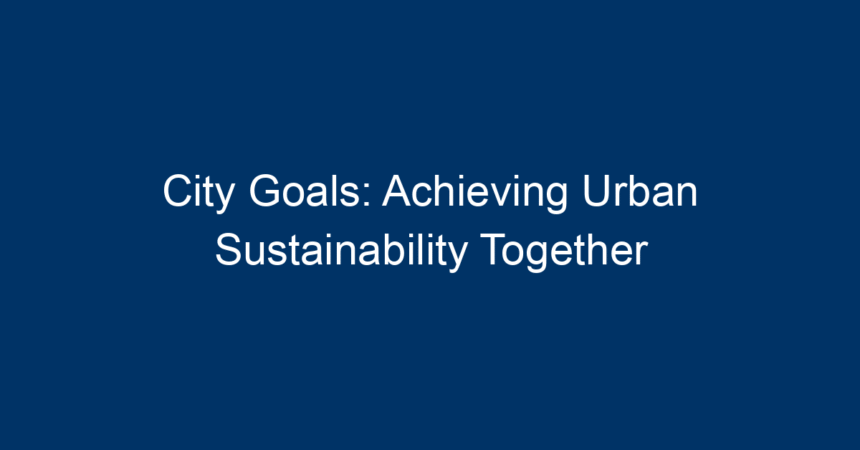In recent years, urban areas across the globe have witnessed unprecedented growth, leading to both opportunities and challenges. With projections indicating that nearly 68% of the world’s population will reside in urban centers by 2050, the need for sustainable urban development has never been more pressing. As cities aim to become more sustainable, city goals must be at the forefront of planning and execution. This article delves into the essence of urban sustainability, the critical role of collaboration, and actionable steps that communities can take to achieve these city goals together.
Understanding Urban Sustainability
What is Urban Sustainability?
Urban sustainability refers to the ability of a city to maintain and improve its social, economic, and environmental health over time. This concept encompasses various elements, including energy efficiency, waste management, pollution reduction, and social equity. The ultimate aim is to create livable, resilient cities that meet the needs of current and future generations.
The Importance of Urban Sustainability
Sustainable cities not only improve the quality of life for residents but also safeguard the environment. By embracing city goals that target sustainability, urban areas can:
- Reduce carbon emissions
- Manage resources more efficiently
- Enhance public health and well-being
- Foster economic growth and job creation
Setting City Goals: The Framework for Action
Identifying Key Areas for Improvement
To effectively pursue urban sustainability, cities must first identify their unique challenges. This process often involves collaboration among various stakeholders, including government officials, community members, and business leaders. Key areas to focus on include:
- Transportation: Transitioning to public transport and non-motorized options can significantly reduce urban congestion and pollution.
- Energy Efficiency: Implementing renewable energy solutions and improving energy efficiency in buildings can drastically cut down resource consumption.
- Waste Management: Developing robust recycling and composting programs can minimize waste and promote a circular economy.
- Green Spaces: Integrating parks, green roofs, and community gardens into urban planning enhances biodiversity and improves mental well-being.
Collaborating for Success
Achieving these city goals requires collaboration at multiple levels. Local governments, private sector players, NGOs, and citizens must come together to create a shared vision for sustainability. This collaborative approach not only pools resources but also fosters innovation and accountability.
Priority Action Plans
-
Developing Sustainable Infrastructure
- Focus on sustainable design principles in new constructions.
- Upgrade existing buildings to meet energy-efficient standards.
-
Promoting Public Transit and Active Transportation
- Invest in public transportation systems that are reliable and affordable.
- Implement bike lanes and pedestrian-friendly pathways.
-
Enhancing Community Engagement
- Facilitate workshops and public forums to involve citizens in decision-making.
- Produce educational campaigns to promote sustainable practices.
- Encouraging Green Practices in Business
- Provide incentives for businesses to adopt sustainable practices.
- Support local economies by sourcing materials and labor locally.
Measuring Success
Setting measurable objectives is vital for evaluating progress toward city goals. Cities should develop key performance indicators (KPIs) based on:
- Carbon emissions reductions
- Increases in waste recycling rates
- Growth in public transport usage
- Improvement in residents’ satisfaction and health outcomes
Regularly reviewing these metrics allows cities to adapt their strategies as needed, ensuring that they remain on track toward achieving urban sustainability.
Innovative Case Studies
Examples of Successful Urban Sustainability Initiatives
Several cities around the world have implemented successful sustainability initiatives that serve as inspiring examples:
1. Copenhagen, Denmark
Copenhagen aims to become the world’s first carbon-neutral city by 2025. The city has invested heavily in wind energy, cycling infrastructure, and public transport. Initiatives like the "Climate Adaptation Plan" aim to manage flooding and other climate-related risks.
2. Curitiba, Brazil
Curitiba was one of the first cities to develop a Bus Rapid Transit (BRT) system, promoting efficient public transport. The city also practices innovative waste management through its Green Exchange program, where residents can exchange recyclables for food vouchers.
3. Singapore
Singapore’s approach to urban sustainability includes the integration of greening into urban design with its "Garden City" initiative. The city utilizes technology and data analytics to optimize resource use and enhance the living environment for its residents.
Learning from Best Practices
These case studies highlight the importance of adaptability, community involvement, and innovation. By analyzing successful approaches from other cities, local governments can tailor sustainable strategies that resonate with their community’s needs and conditions.
Community Engagement: The Heart of Urban Sustainability
Empowering Local Voices
A sustainable city is ultimately a reflection of its residents’ needs and values. Engaging the community ensures a broader support base for sustainability initiatives. Fostering a sense of ownership among residents can lead to more effective implementation of city goals.
Strategies for Engagement
- Social Media Campaigns: Utilize platforms to spread awareness about sustainability issues and goals.
- Volunteer Days: Organize community clean-up and planting events to bolster civic pride and environmental stewardship.
- Workshops and Training: Educate citizens about sustainable practices, waste reduction, and energy efficiency through hands-on training and workshops.
Policies Supporting Urban Sustainability
Governmental Role in Driving Change
Effective policy is crucial for steering cities toward their city goals. Policymakers must create a conducive environment for sustainable development through:
- Incentives: Tax breaks and subsidies for businesses adopting sustainable practices.
- Regulatory Frameworks: Enacting laws that mandate sustainability benchmarks in construction and transportation.
- Funding for Research: Supporting scientific and technological innovation in sustainability practices.
Advocacy and Grassroots Movements
Community-driven movements often lead to significant changes in local policies. Encouraging grassroots advocacy can create pressure on local governments to prioritize sustainable initiatives. This collaboration ensures that sustainability is viewed not just as a governmental priority but as a community commitment.
Conclusion: Pathway to a Sustainable Future
Achieving urban sustainability is not merely an individual or governmental task; it is a collective effort guided by well-defined city goals. By fostering collaboration, empowering communities, and establishing innovative policies, cities can pave the way toward a more sustainable future.
Actionable Insights for Residents and Stakeholders
- Educate Yourself: Stay informed about local sustainability initiatives and participate in workshops.
- Engage with Local Government: Attend town hall meetings to voice your opinion on sustainability goals.
- Adopt Sustainable Practices: Implement simple changes in your daily life, such as reducing waste and using public transport.
- Collaborate with Others: Join local organizations and initiatives focused on sustainability.
By working together, cities can transform their landscapes, promote well-being, and ensure a sustainable future for generations to come. Every small action counts in the pursuit of effective city goals—let’s achieve urban sustainability together!




